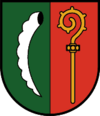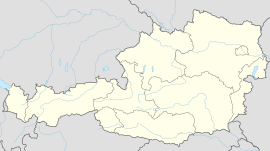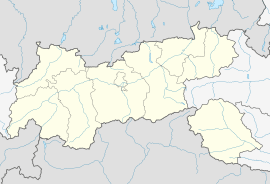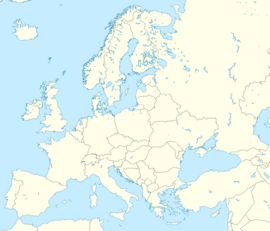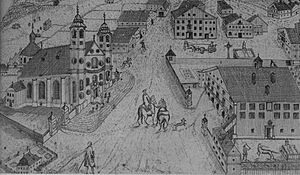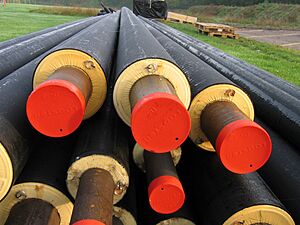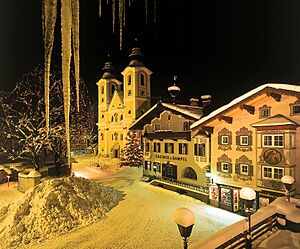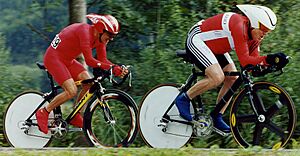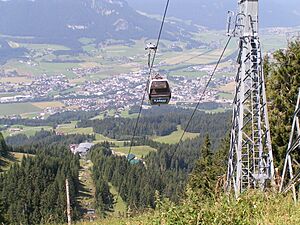St. Johann in Tirol facts for kids
Quick facts for kids
St. Johann in Tirol
Sainihåns
St. Johann im Leukental
|
||
|---|---|---|
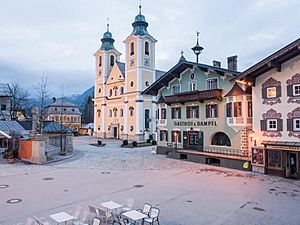
Market square with the Dekanatspfarrkirche Maria Himmelfahrt
|
||
|
||
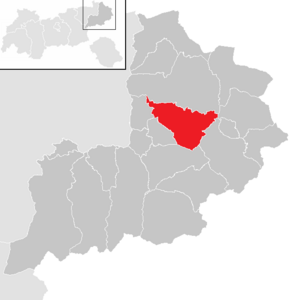
Area of the municipality (red) within the Kitzbühel district (dark gray) of Tyrol (light gray)
|
||
| Country | Austria | |
| State | Tyrol | |
| District | Kitzbühel | |
| Earliest record as church | AD/CE | |
| Earliest record as parish | 26 January 1216 | |
| Elevated to market town | 1956 | |
| Named for | St. John the Baptist | |
| Area | ||
| • Total | 59.15 km2 (22.84 sq mi) | |
| Elevation | 659 m (2,162 ft) | |
| Highest elevation | 2,231 m (7,320 ft) | |
| Time zone | UTC+1 (CET) | |
| • Summer (DST) | UTC+2 (CEST) | |
| Postal code |
6380
|
|
| Area code | +43 5352 | |
| Vehicle registration | KB | |
Sankt Johann in Tirol, often called Sainihåns by locals, is a lively market town in the Kitzbühel district of Tyrol, Austria. It's a special kind of town called a "market municipality." The name comes from St. John the Baptist.
Contents
Exploring the Geography of St. Johann
St. Johann in Tirol is located in the middle of the Leukental valley. This valley is part of the Tyrolean Unterland region. The town sits in a wide, bowl-shaped area formed by glaciers.
Mountains and Rivers Around St. Johann
To the northwest of St. Johann, you'll find the Wilder Kaiser mountains. These are part of the Kaisergebirge range. To the east are the Loferer and Leoganger Steinberge. The valley of the Fieberbrunner Ache river stretches to the southeast. In the south, the Kitzbüheler Horn mountain rises almost 2,000 meters high. It's a key part of the Kitzbühel Alps.
St. Johann is in a valley, so it usually avoids strong Alpenföhn winds. However, it gets a lot of snow because it's on the windy side of the Wilder Kaiser. The town center is about 660 meters above sea level. The highest point in the area is the Maukspitze mountain, which is 2,231 meters high.
The main river, the Großache, flows through St. Johann. The part of the river coming from Kitzbühel is called the Kitzbüheler Ache. Other rivers, like the Aschauer Ache and the Fieberbrunner Ache, join the Großache here. The Großache eventually flows into the Chiemsee lake in Bavaria, Germany.
How People Get Around St. Johann
St. Johann is an important place for travel. It has a train station and several main roads meet here. The Loferer Straße (B 178) goes through the town from west to northeast. It connects St. Johann to places like Going am Wilden Kaiser and Kirchdorf in Tirol.
The Kössener Straße (B 176) branches off to the north. It leads towards Schwendt. The Hochkönigstraße (B 164) goes southeast towards Fieberbrunn.
Villages and Hamlets in St. Johann
The area of St. Johann in Tirol includes several smaller villages and hamlets. These include Almdorf, Apfeldorf, Bärnstetten, Berglehen, Fricking, Hinterkaiser, Mitterndorf, Niederhofen, Oberhofen, Reitham, Rettenbach, Scheffau, Sperten, Taxa, Weiberndorf, Weitau, Winkl Schattseite, and Winkl Sonnseite.
Population Growth in St. Johann
In 2001, St. Johann had 7,959 people living there. The number of people in the town has been growing steadily. Since 2007, St. Johann in Tirol has been the most populated town in the Kitzbühel district.
| Historical population | |||||||||||||||||||||||||||||||||||||||||||||||||||||||
|---|---|---|---|---|---|---|---|---|---|---|---|---|---|---|---|---|---|---|---|---|---|---|---|---|---|---|---|---|---|---|---|---|---|---|---|---|---|---|---|---|---|---|---|---|---|---|---|---|---|---|---|---|---|---|---|
|
|
||||||||||||||||||||||||||||||||||||||||||||||||||||||
| Source: Statistik Austria | |||||||||||||||||||||||||||||||||||||||||||||||||||||||
A Look Back at St. Johann's History
St. Johann is located in the Leukental valley. This area has been settled for a very long time. Around 400 BC, a Celtic tribe called the Ambisontiers lived here. They were involved in copper mining in the nearby mountains.
From Roman Times to Medieval Lords
In 15 BC, the Romans took control of this part of the Alps. The Leukental became part of the Roman province of Noricum. After the Roman Empire fell in 476 AD, the region became part of the Duchy of Bavaria. This happened around the 7th century, when the Germanic tribe of the Bavarii settled here.
Later, a noble family called the Liuchingers ruled the valley. The Leukental is named after them. They lived in Leukenstein Castle, but its exact location is now unknown. After the Liuchingers, the Falkensteins took over. When they died out, Bavarian dukes ruled the area through their officials.
The Church and Mining Boom
In the 8th century, missionaries built a Catholic church in the St. Johann area. It was named after St. John the Evangelist, which is where the town's name comes from. The church of St. Johannes was first mentioned in a document in 1150. In 1446, the bishops of Chiemsee became responsible for the parish. St. Johann then became their summer home.
The discovery of copper and silver mines in 1540 brought a lot of wealth to St. Johann. These mines were in the hills near Oberndorf. In the 17th century, one mine shaft, the Heilig-Geist-Schacht, was the deepest in the world, over 780 meters deep! Mining continued until the 18th century.
In 1875, the Gisela Railway was built. This connected St. Johann to the international railway network. This led to a big economic boost, and tourism started to grow.
St. Johann in the 20th Century
In 1927, Oberndorf became a separate parish from St. Johann. In 1954, St. Johann received its own Coat of Arms. Then, in 1956, St. Johann was officially made a market town.
Economy and Life in St. Johann
Tourism and restaurants are very important to St. Johann's economy. The town has about 520,000 overnight stays each year, split between summer and winter. This makes it one of Tyrol's main tourist spots. You can find everything from hotels and campsites to restaurants and discos.
St. Johann has also grown a lot in trade, services, and light industry. It has become the main shopping center for the Kitzbühel district. Many new businesses have opened here, especially along the B 178 road. The town center also improved with a pedestrian zone in the 1990s. About 20,000 visitors come to the town center every day.
Some big companies are based in St. Johann. For example, the headquarters of Fritz Egger GmbH & Co, a well-known chipboard maker, is here.
Farming is also a big part of the region's life. St. Johann has a long history as a farming area, even with its tough climate. Many farms are located in the wide, flat basin and on the gentle slopes. About a third of the farms provide the main income for families.
St. Johann in Tirol is a popular place for tourists, especially for skiing. The ski resorts are very busy from Christmas into early January. It's also popular in summer, especially with visitors from Britain, Ireland, and Germany. The Kitzbühler Horn mountain is a major feature, with many ski lifts and cable cars.
Modern Infrastructure in St. Johann
Getting Around: Transport Links
St. Johann is a major transport hub. Several important roads meet here: B 178 (Loferer Straße), B 164 (Hochkönig Straße), B 176 (Kössener Straße), and B 161 (Pass Thurn Straße). European route E641, which connects Wörgl with Salzburg, also passes through St. Johann.
The town has a train station on the Giselabahn line, also called the Salzburg-Tyrol Railway. This connects St. Johann to the international railway network, with trains to Salzburg, Innsbruck, and Munich.
There's also an airport for light aircraft and gliders, called LOIJ. It has a runway length of 645 meters. This is the second largest airport in Tyrol.
- Distance to Salzburg: 65 km
- Distance to Innsbruck: 100 km
- Distance to Munich: 125 km
Important Public Services
St. Johann has many important public services. These include the district hospital and the Wintersteller army barracks. There's also a Military Supply Centre for the Austrian Armed Forces.
Other important places include:
- The District Forest Inspector
- The District Administration for Agriculture
- The Road Maintenance Department
- A nursing home
- Health and social care services
- The police department
Water, Waste, and Heating Systems
The town council manages the water supply, sewage, and waste disposal systems. Besides electricity and natural gas, St. Johann also has an environmentally friendly district heating system. This system started in late 2008 and heats the largest buildings in the village.
The St. Johann Village Heating Company supplies homes, businesses, and public buildings with district heating. This company is mostly owned by the town of St. Johann. The energy for heating comes from the Egger factory. They use waste heat and biomass to create energy.
By the end of 2009, about 400 buildings and 1,300 homes in St. Johann used district heating. This includes the hospital, barracks, schools, and many homes. The system uses about 56 km of pipes. In 2009, it saved about 12,000 tonnes of carbon dioxide from being released each year.
Learning and Education Opportunities
St. Johann offers many educational options for young people and adults:
- 1 Grammar School
- 1 Institution of Higher Education for Tourism
- 1 Agricultural School
- 1 Music School
- 1 Polytechnic Institute
- 2 Secondary Schools
- 2 Elementary Schools
- 1 Special Needs Educational Centre
- 1 Montessori School
- 1 Adult Education Centre
- 4 Kindergartens
- 2 Nursery Schools
Culture and Fun Things to See
Museums to Visit
- Town Museum: This museum shows the local history of St. Johann. It also has an art gallery with modern art.
- Alpine Museum: Located in Oberhofenweg, this museum focuses on the Alps.
Cool Sights to Explore
- Roman Catholic parish church of St. John: A beautiful and historic church.
- St. Anthony's Chapel: A small, peaceful chapel.
- St. Nicholas' Church in Weitau: Another historic church.
- Town center: Great for walking around and seeing the local life.
Sports and Outdoor Activities
St. Johann has many sports facilities for everyone to enjoy:
- Indoor and outdoor swimming pool with sauna and steam bath
- Tennis courts (indoor and outdoor)
- Crazy golf
- Mountain bike routes
- Paths for cycling and walking
- Archery, rifle, pistol, and air gun shooting ranges
- Circuit training exercise path
- Football stadium (Koasastadion)
- Riding hall, bridleway, horse-trotting course
- Kayaking and rafting
- 60 km of ski runs (half with artificial snow), with gondolas, chairlifts, and draglifts
- Cross-country ski circuits
Exciting Annual Events
Since 2004, St. Johann has a modern event hall called the Kaisersaal. It's named after the "Wilder Kaiser" mountain range. Many events happen here, like lectures, company events, and concerts.
- Koasalauf: One of the biggest cross-country ski races, held in January.
- Summer night festival "Jaggasn": Held in July.
- UCI cycling race of the seniors: Held in August.
- Dumpling festival: A fun festival celebrating dumplings, held in September.
Famous People from St. Johann
- Edmund Angerer (1740–1774): A composer who wrote a children's symphony.
- Andrea Fischer (born 1973): A scientist who studies glaciers.
- Emma Hellenstainer (1817–1904): A pioneer in Tyrolean hotel and restaurant business.
- Axel Theimer (born 1946): A choir conductor, composer, and singer.
- DJ Ötzi (Gerhard Friedle, born 1971): A famous Austrian singer and entertainer.
- Andreas Widhölzl (born 1976): An Austrian ski jumper.
See also
 In Spanish: St. Johann in Tirol para niños
In Spanish: St. Johann in Tirol para niños


